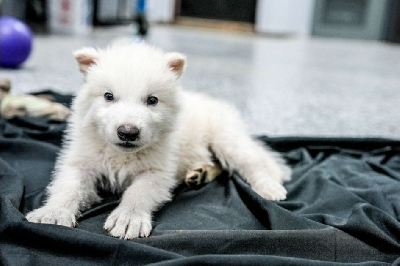This post was published by a guest. The views expressed are those of the author and do not necessarily reflect the views of Scified.com.
Colossal Biosciences' successful resurrection of the dire wolf (Aenocyon dirus) represents more than just the world's first de-extinction—it's also set a new record in the field of precision genetic engineering. The company performed an unprecedented 20 precise edits to the genome of the gray wolf to recreate dire wolf traits, establishing the highest number of deliberate genome edits ever achieved in a living vertebrate.
Setting a New Standard
This genetic engineering milestone significantly surpasses Colossal's previous achievement with the "woolly mouse," which featured 8 precision edits to incorporate mammoth genes. The 20 edits in the dire wolf project, which include 15 extinct variants that haven't existed for over 12,000 years, demonstrate remarkable progress in multiplex genome editing capabilities.
"The dire wolf is an early example of this, including the largest number of precise genomic edits in a healthy vertebrate so far—a capability that is growing exponentially," said Harvard geneticist and Colossal co-founder Dr. George Church.
The Genetic Engineering Blueprint
The company's approach to resurrecting the dire wolf followed a methodical process that began with extracting and sequencing ancient DNA from two dire wolf fossils: a 13,000-year-old tooth from Sheridan Pit, Ohio, and a 72,000-year-old inner ear bone from American Falls, Idaho. Through deep sequencing and novel iterative assembly techniques, Colossal's team produced high-quality ancient genomes with significantly more coverage than was previously available.
Computational analysis of these reconstructed genomes revealed that gray wolves share 99.5% of their DNA with dire wolves, making them the closest living relatives and ideal candidates for genetic modification. The analysis also uncovered the hybrid ancestry of dire wolves, which emerged between 3.5 and 2.5 million years ago through hybridization between two ancient canid lineages.
Target Genes and Traits
Colossal's scientists identified key genetic variants unique to dire wolves that influence their distinctive characteristics. Among the 14 genes targeted for modification were:
- CORIN: A serine protease expressed in hair follicles that suppresses the agouti pathway, impacting coat color and patterning. The dire wolf CORIN variants lead to a light coat color.
- Multi-gene regulatory module: A genetic region associated with body size, ear, skull, and facial morphology. This module encodes eight genes that establish species-specific constraints in skeletal size and structure.
- HMGA2: A gene within the regulatory module directly associated with body size in canids.
- MSRB3: Another gene in the module linked to variation in ear and skull shape among canines and mammals.
- LCORL: A transcription factor that regulates gene expression and has been linked to body size variation in numerous species, including humans, horses, and canids.
- Pigmentation genes: Including OCA2, SLC45A2, and MITF, which directly impact the function and development of melanocytes and contribute to the dire wolf's light coat.
Careful Engineering to Avoid Side Effects
The Colossal team took great care to ensure that their genetic modifications would produce healthy animals. For each high-impact variant identified, they created a detailed profile of all potential impacts on the donor gray wolf genome.
In some cases, this led to creative adaptations of the original dire wolf genetics. For example, while dire wolves have protein-coding substitutions in three essential pigmentation genes that would lead to a light coat, these same variants in gray wolves could potentially cause deafness and blindness. To achieve the desired light coat without harmful side effects, the team instead induced loss-of-function to MC1R and MFSD12, genes that influence pigment expression in a way that's known to be safe in gray wolves.
"By choosing to engineer in variants that have already passed evolution's clinical trial, Colossal is demonstrating their dedication to an ethical approach to de-extinction," noted Elinor Karlsson, Ph.D., Associate Professor in Bioinformatics and Integrative Biology at the UMass Chan Medical School.
From Edited Cells to Living Wolves
After the genetic modifications were complete, Colossal employed somatic cell nuclear transfer (cloning) techniques to create viable embryos. The edited cell nuclei were transferred into donor egg cells, which were then allowed to develop before being implanted into surrogate mothers—domestic dogs (hound mixes) chosen for their genetic compatibility.
The result was the birth of three healthy dire wolf pups: males Romulus and Remus in October 2024, and female Khaleesi in January 2025. All three were delivered via scheduled cesarean section, and notably, Colossal reported no miscarriages or stillbirths during these trials—an exceptionally successful outcome for such complex genetic engineering.
Beyond Breaking Records
While setting a new standard for multiplex genome editing is scientifically significant, the implications extend far beyond record books. These same technologies are already being applied to conservation efforts, as demonstrated by Colossal's successful cloning of critically endangered red wolves using the same techniques.
Dr. Christopher Mason, a Colossal scientific advisor, emphasized this connection: "The same technologies that created the dire wolf can directly help save a variety of other endangered animals as well. This is an extraordinary technological leap for both science and conservation."
As the dire wolf pups continue to develop, displaying the classic traits engineered into their genomes—thick white fur, broad heads, hefty builds, and wild instincts—they stand as living proof of how far genetic engineering capabilities have advanced. More importantly, they demonstrate how these technologies might be applied to address the current biodiversity crisis, potentially offering new tools to prevent extinctions and even restore lost species.

How Poor Timing Can Ruin Even the Best Forex Trading Strategies
Forex trading depends on timing. Even the strongest strategy can fail when trades occur at the wrong hour. Each session moves with its own rhythm. The...

Loans for Delinquent Borrowers: Yes, You Still Have Options
Financial setbacks can derail even the most responsible individuals. Missed payments, fluctuating income, unexpected emergencies, or accumulated debt ...

Overseas Gift Lending Account: A Smart Choice for Cross-Border Support
In an era defined by globalization and digital connectivity, the concept of an Overseas Gift Lending Account has emerged as a vital financial tool for...

Top Player Poker Money Prize: The Ultimate Guide to Record-Breaking Winnings
In the world of high-stakes gaming, top player poker money prizes represent far more than just impressive dollar amounts—they symbolize mastery,...

5 Best Pennsylvania Casino Apps for Real Money in 2025
Mobile gaming has completely transformed downtime. Pennsylvania casino apps let you play slots, hit the blackjack tables, or spin roulette w...


